In this issue:
The Managing
Members will discuss and finalize the 2017 CEO performance goals and
expectations with CEO John Wolfe on Tuesday, Feb. 7. The Managing Members also
will consider surplusing three cranes. View the full agenda.
The special
joint meeting with the Port of Seattle begins at 11:30 a.m. at the SeaTac
Conference Center at 17801 International Blvd. in SeaTac. Meetings are streamed live
from the alliance’s website.
 The NWSA
welcomed newly elected Congresswoman Pramila Jayapal to the North Harbor on
Jan. 27. Jayapal was joined by Port of Seattle Commissioner Fred Felleman and
other port, labor and business representatives.
The visit
included a tour of Terminals 5 and 18, guided by Foss Maritime Company and SSA
Marine, respectively. Afterward, Foss Maritime Company hosted a roundtable
discussion with maritime industry stakeholders.
During her
visit, Rep. Jayapal expressed that it is her goal to “lift up the maritime
industry,” and that it is “an incredible source of family-wage jobs.”
Thriving cargo
ports are important for our region’s economy. Our marine cargo facilities in
Seattle and Tacoma generate 48,100 jobs, including 19,000 direct transportation
sector jobs.
Thank you, Rep.
Jayapal, for taking the time to meet with us and learn more about the alliance.
|
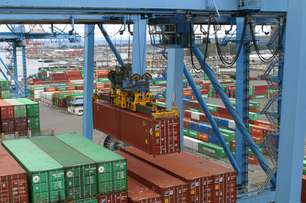 In 2016, The
Northwest Seaport Alliance handled 3,615,752 TEUs (20-foot equivalent units)
for the year, an increase of more than 2 percent from 2015 volumes.
Full imports
for the year were up 6 percent to 1,391,590 TEUs and full exports increased 13
percent to 984,274 TEUs.
Domestic
volumes saw a slight dip in 2016 as Alaska struggled with a decline in oil- and
gas-related project activity due to low commodity prices. Domestic volumes decreased
1.5 percent for the year.
December’s full
import volumes recorded their highest for the month over the last five years.
Following a solid November for full international imports and
exports, The Northwest Seaport Alliance delivered another strong month in
December with 14 percent and 6 percent increases, respectively, compared with
December 2015.
Other cargo:
- Breakbulk
cargo is down 23 percent for the year to 181,372 metric tons as the global
downturn in agricultural, mining and construction equipment, and a strong U.S.
dollar impact volumes.
- Log
exports declined 25 percent for the year to 176,928 metric tons due to
decreased demand in China and competition from New Zealand.
- Autos
units fell 10 percent to 165,687 units for year because of production issues as
well as supply chain shifts.
View the
December 2016 cargo reports:
|
 We will be
working gates in Seattle and Tacoma over the next couple of weeks, helping
drivers download the DrayQ and DrayLink apps and
handing out free vests.
DrayQ aims to
give truck drivers real-time information about wait times in and around marine
cargo terminals, and DrayLink will interconnect the drayage community to better
dispatch, track and record container moves from pickup to delivery.
The apps were
designed specifically for, and in partnership with, the port industry to align
with the U.S. Department of Transportation’s Connected Vehicle Freight Advanced
Traveler Information System (FRATIS) architecture and StrongPorts initiative.
DrayQ is the
first mobile app in the market to use Bluetooth technology to provide real-time
estimates of drayage truck wait times at ports and terminals. The app also
provides trend information and traffic camera views at the touch of a
fingertip.
Learn more about the program.
|
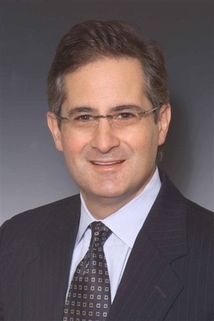 The
Agriculture Transportation Coalition (AgTC) held one of its annual Agriculture
Shipper Workshops in Tacoma on Jan. 24. The meeting included presentations and
an informal roundtable discussion where agriculture exporters in the Pacific
Northwest discussed the challenges and issues facing the industry.
We caught up
with Peter Friedmann, executive director of the AgTC, who shared his thoughts
about the significance of the Pacific Northwest to the agriculture
transportation industry and why it’s important to maintain a competitive global
market.
The Northwest Seaport
Alliance (NWSA): What is your objective for the Agriculture Transportation
Coalition/U.S. Department of Agriculture (USDA) Ag Shipper Workshop?
Peter Friedmann (PF): This AgTC/USDA Ag Shipper Workshop is
one of seven that we host around the country every year. Held jointly with the
USDA, the workshop provides a means in which agriculture, forest products and
other commodities exporters can be competitive in the global marketplace.
At
this workshop in Tacoma, we’ll have 100 exporters from a wide range of
agricultural products like hay, apples, cotton and lumber. Every one of them
fights with foreign producers for market share in countries like Japan, China
and Korea.
NWSA: Why is it important
to remain competitive in this market share?
PF: It’s important because there is nothing
that we produce in this country for global export that cannot be sourced
somewhere else in the world. So the hay that comes from Washington state can
also come from Australia, Canada, Argentina and other countries. For example,
the hay produced in Washington state currently goes to Japan, Korea and China.
But if our prices are too high; if we can’t deliver it affordably and
dependably; if our transportation network isn’t efficient; if our ports aren’t
functioning efficiently, then those consumers in Asia will say, ‘If we can’t
get it affordably and dependably from the U.S. farmers, then we’ll go to other
countries that source the same products.’ So it’s a very competitive global
market. Often times, the differentiating factor is how efficient our
transportation network is, and if port authorities are not operating
efficiently, then it kills the sale. Click
here to read the full interview.
|
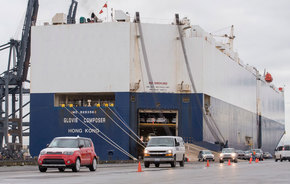 The Northwest Seaport Alliance unloaded more than 4,800 vehicles off the Glovis Composer auto ship upon its Jan. 9 arrival at Terminal 7 in Tacoma.
At 656 feet long (200 meters) and 106 feet wide (32 meters), the roll-on/roll-off (ro-ro) ship has a total capacity to transport 6,400 vehicles. During this call, the South Harbor received 4,818 vehicles in addition to six high and heavy cargoes, making it the single-largest auto discharge off a vessel in the Port of Tacoma’s history. In 2016, discharges from this same vessel averaged around 1,825 cars.
These vehicles will be transported throughout the country and are expected to reach as far east as Chicago and Ohio.
|
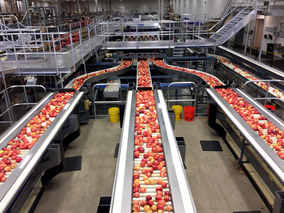 The
Northwest Seaport Alliance staff recently visited Eastern Washington, where we
hosted two roundtable events with our export customers.
Our first roundtable
was held in Kennewick, which coincided with the Northwest Hay Expo.
Representatives from the hay export community offered their feedback on the
direction of the NWSA and made suggestions for how we can help them grow their
exports. We also traveled to Yakima to meet with the apple export community and
listen to their ideas.
We also visited the Superfresh Growers facility in Yakima to learn about how it safely grows,
packs and ships Washington apples and cherries all over the world.
On average,
Washington state grows 125 million boxes of apples per year. At 40 pounds per
box, that’s 2.5 million tons of apples!
|
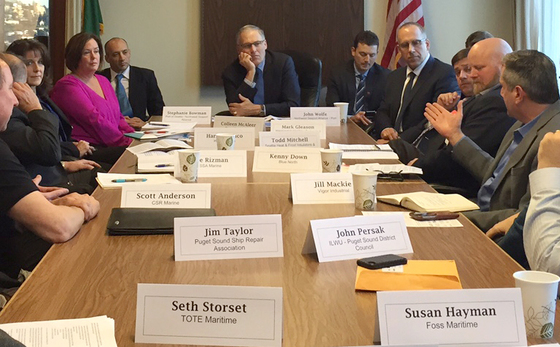
Port of Seattle Commissioner Stephanie Bowman, NWSA CEO John Wolfe and others within the maritime industry met with Gov. Jay Inslee and the Washington State Department of Commerce in Seattle on Jan. 12. Their discussion included a briefing on the state of the industry, future partnership opportunities and job creation.
As a pioneer in creating the marine cargo operating
partnership between ports of Tacoma and
Seattle, the NWSA is paving the way for other ports
around the world to explore similar routes. A delegation of Port of Tianjin
representatives visited the North and South harbors in January to learn more
about the alliance. In the past year, ports of Tangshan and Tianjin in northern
China have agreed to consolidate their container terminal businesses.
|